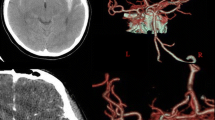Abstract
Craniocervical arterial dissection is an important cause of arterial ischemic stroke in children. Recognition of dissections is of particular importance both in determining the risk of recurrence and in bringing about different treatment alternatives. We report a 10-year-old girl who presented with acute ischemic stroke due to spontaneous long segment dissection involving the parasellar internal carotid artery up to the distal M1 portion of the middle cerebral artery. Three-dimensional digital subtraction angiography with flat panel detector revealed the presence of major vessels originating from both true and false lumens and had a critical role in the treatment decision of the case.




Similar content being viewed by others
References
Mackay M, Kirton A, deVeber G (2017) Arterial ischemic stroke in infants and children. In: Swaiman’s pediatric neurology, 6th edn. Elsevier, Edinburgh, pp 848–857
Tan MA, Deveber G, Kirton A et al (2009) Low detection rate of craniocervical arterial dissection in children using time-of-flight magnetic resonance angiography: causes and strategies to improve diagnosis. J Child Neurol 24:1250–1257. https://doi.org/10.1177/0883073809333539
Stence NV, Fenton LZ, Goldenberg NA, Armstrong-Wells J, Bernard TJ (2011) Craniocervical arterial dissection in children: diagnosis and treatment. Curr Treat Options Neurol 13:636–648. https://doi.org/10.1007/s11940-011-0149-2
Rafay MF, Armstrong D, Deveber G et al (2006) Craniocervical arterial dissection in children: clinical and radiographic presentation and outcome. J Child Neurol 21:8–16. https://doi.org/10.1177/08830738060210010101
Kernan WN, Ovbiagele B, Black HR et al (2014) Guidelines for the prevention of stroke in patients with stroke and transient ischemic attack. Stroke 45:2160–2236. https://doi.org/10.1161/str.0000000000000024
Lucas C, Moulin T, Deplanque D, Tatu L, Chavot D (1998) Stroke patterns of internal carotid artery dissection in 40 patients. Stroke 29:2646–2648. https://doi.org/10.1161/01.str.29.12.2646
Morel A, Nagara O, Touze E (2012) Mechanism of ischemic infarct in spontaneous cervical artery dissection. J Vasc Surg 56:876. https://doi.org/10.1016/j.jvs.2012.07.018
Debette S, Compter A, Labeyrie M-A, Uyttenboogaart M, Metso TM, Majersik JJ, Goeggel-Simonetti B, Engelter ST, Pezzini A, Bijlenga P, Southerland AM, Naggara O, Béjot Y, Cole JW, Ducros A, Giacalone G, Schilling S, Reiner P, Sarikaya H, Welleweerd JC, Kappelle LJ, de Borst GJ, Bonati LH, Jung S, Thijs V, Martin JJ, Brandt T, Grond-Ginsbach C, Kloss M, Mizutani T, Minematsu K, Meschia JF, Pereira VM, Bersano A, Touzé E, Lyrer PA, Leys D, Chabriat H, Markus HS, Worrall BB, Chabrier S, Baumgartner R, Stapf C, Tatlisumak T, Arnold M, Bousser MG (2015) Epidemiology, pathophysiology, diagnosis, and management of intracranial artery dissection. Lancet Neurol 14:640–654. https://doi.org/10.1016/s1474-4422(15)00009-5
Robertson WC, Given CA (2006) Spontaneous intracranial arterial dissection in the young: diagnosis by CT angiography. BMC Neurol 6:16. https://doi.org/10.1186/1471-2377-6-16
Engelter ST, Grond-Ginsbach C, Metso TM, Metso AJ, Kloss M, Debette S, Leys D, Grau A, Dallongeville J, Bodenant M, Samson Y, Caso V, Pezzini A, Bonati LH, Thijs V, Gensicke H, Martin JJ, Bersano A, Touzé E, Tatlisumak T, Lyrer PA, Brandt T, Cervical Artery Dissection and Ischemic Stroke Patients Study Group (2013) Cervical artery dissection: trauma and other potential mechanical trigger events. Neurology 80:1950–1957. https://doi.org/10.1212/wnl.0b013e318293e2eb
Spontaneous cerebral and cervical artery dissection: clinical features and diagnosis [UpToDate Web site]. March 5, 2019. Available at: https://www.uptodate.com/contents/spontaneous-cerebral-and-cervical-artery-dissection-clinical-features-and-diagnosis. Accessed July 16, 2019
Schievink WI (2001) Spontaneous dissection of the carotid and vertebral arteries. N Engl J Med 344:898–906. https://doi.org/10.1056/nejm200103223441206
Brandt T, Orberk E, Weber R, Werner I, Busse O, Müller BT, Wigger F, Grau A, Grond-Ginsbach C, Hausser I (2001) Pathogenesis of cervical artery dissections: association with connective tissue abnormalities. Neurology. 57:24–30. https://doi.org/10.1212/wnl.57.1.24
Provenzale JM, Sarikaya B (2009) Comparison of test performance characteristics of MRI, MR angiography, and CT angiography in the diagnosis of carotid and vertebral artery dissection: a review of the medical literature. Am J Roentgenol 193:1167–1174. https://doi.org/10.2214/ajr.08.1688
Vertinsky A, Schwartz N, Fischbein N et al (2008) Comparison of multidetector CT angiography and MR imaging of cervical artery dissection. Am J Neuroradiol 29:1753–1760. https://doi.org/10.3174/ajnr.a1189
Béatrice H, Rodesch G, Lasjaunias P et al (2002) Magnetic resonance angiography in childhood arterial brain infarcts. Stroke 33:1280–1285. https://doi.org/10.1161/01.str.0000014504.18199.0d
Mirsky DM, Beslow LA, Amlie-Lefond C, Krishnan P, Laughlin S, Lee S, Lehman L, Rafay M, Shaw D, Rivkin MJ, Wintermark M, International Paediatric Stroke Study Neuroimaging Consortium and the Paediatric Stroke Neuroimaging Consortium (2017) Pathways for neuroimaging of childhood stroke. Pediatr Neurol 69:11–23. https://doi.org/10.1016/j.pediatrneurol.2016.12.004
Rodallec MH, Marteau V, Gerber S et al (2008) Craniocervical arterial dissection: spectrum of imaging findings and differential diagnosis. Radiographics 28(6):1711–1728. https://doi.org/10.1148/rg.286085512
Overview: stroke and transient ischaemic attack in over 16s: diagnosis and initial management: Guidance. [NICE Web site]. May, 2019. Available at: https://www.nice.org.uk/guidance/ng128. Accessed July 16, 2019
Lansberg MG, O’Donnell MJ, Khatri P, Lang ES, Nguyen-Huynh MN, Schwartz NE, Sonnenberg FA, Schulman S, Vandvik PO, Spencer FA, Alonso-Coello P, Guyatt GH, Akl EA (2012) Antithrombotic and thrombolytic therapy for ischemic stroke: antithrombotic therapy and prevention of thrombosis: American College of Chest Physicians Evidence-Based Clinical Practice Guidelines. Chest 141:e601S–e636S. https://doi.org/10.1378/chest.11-2302
Kirton A, Wong JH, Mah J et al (2003) Successful endovascular therapy for acute basilar thrombosis in an adolescent. Pediatrics 112. https://doi.org/10.1542/peds.112.3.e248
Chern JJ, Chamoun RB, Mawad ME, Whitehead WE, Curry DJ, Luerssen TG, Jea A (2009) Endovascular stenting of traumatic extracranial carotid artery dissections in the pediatric population: a case report. Cases J 2:171. https://doi.org/10.1186/1757-1626-2-171
Felker MV, Zimmer JA, Golomb MR (2010) Failure of a clot retrieval device in an adolescent stroke patient. Pediatr Neurol 43:435–438. https://doi.org/10.1016/j.pediatrneurol.2010.06.010
Khayat M, Cooper KJ, Khaja MS et al (2018) Endovascular management of acute aortic dissection. Cardiovasc Diagn Ther 8(Suppl 1):97–107. https://doi.org/10.21037/cdt.2017.10.07
Author information
Authors and Affiliations
Corresponding author
Ethics declarations
Conflict of interest
The authors declare that there is no conflict of interest regarding the submitted material.
Statement of informed consent
Informed consent was obtained from the participant included in the study.
Additional information
Publisher’s note
Springer Nature remains neutral with regard to jurisdictional claims in published maps and institutional affiliations.
Rights and permissions
About this article
Cite this article
Simsek, E., Yilmaz, S., Oran, I. et al. A rare cause of ischemic stroke in childhood: spontaneous long segment intracranial dissection. Childs Nerv Syst 36, 2871–2875 (2020). https://doi.org/10.1007/s00381-020-04530-9
Received:
Accepted:
Published:
Issue Date:
DOI: https://doi.org/10.1007/s00381-020-04530-9




